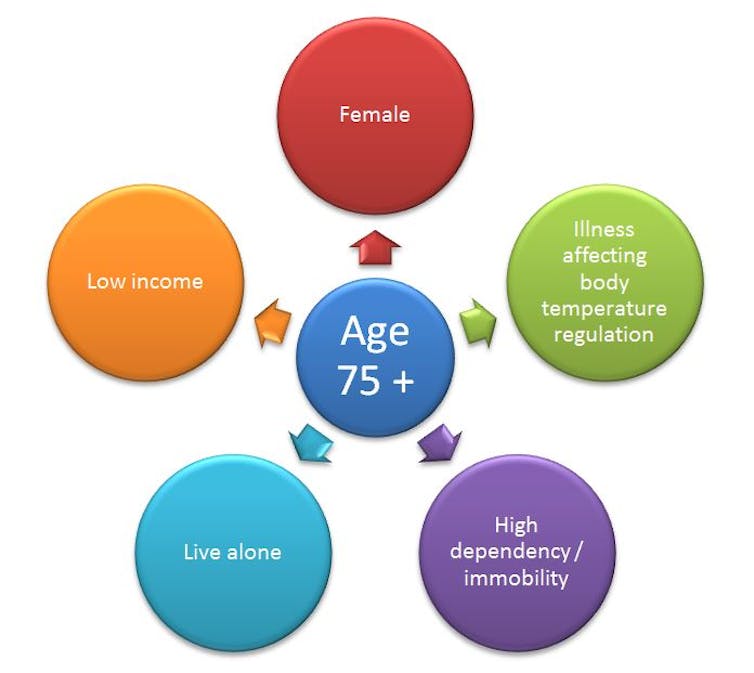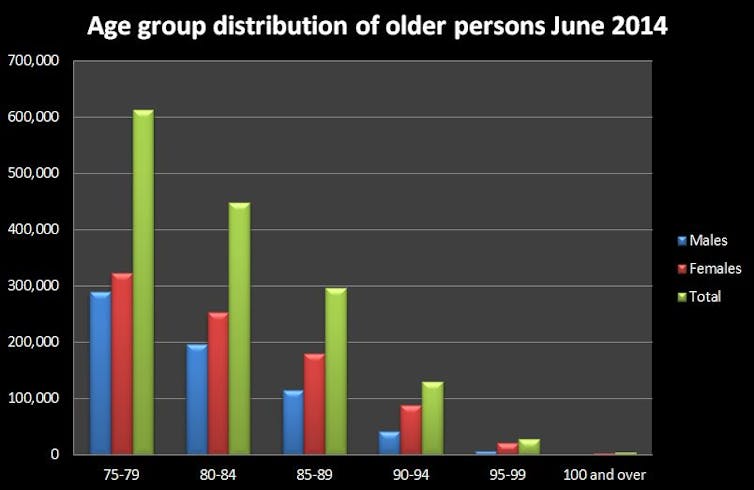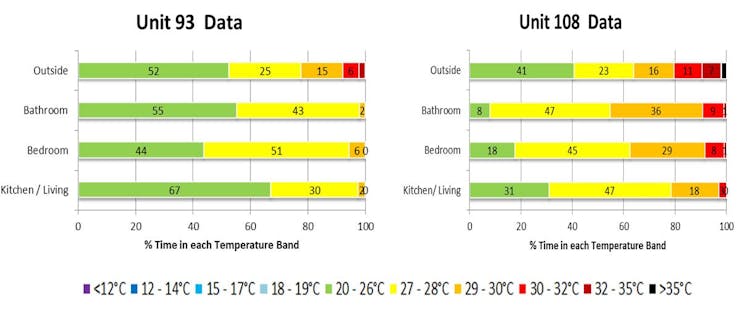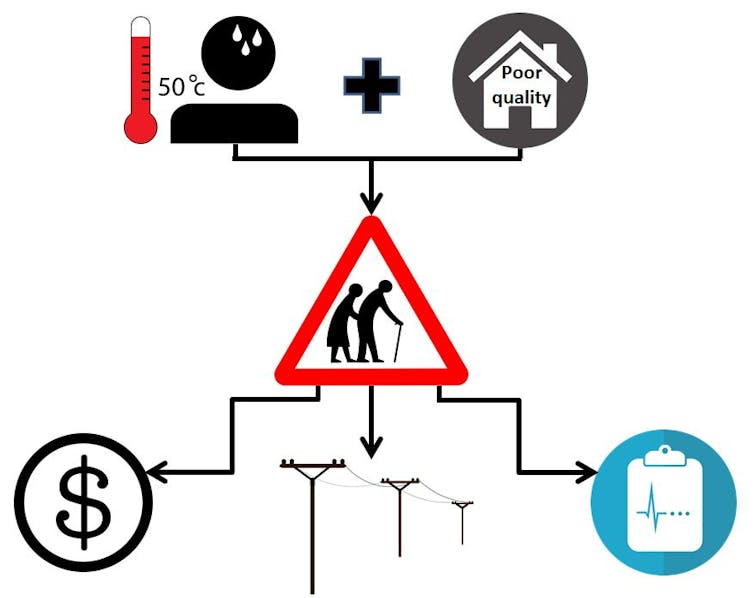To keep heatwaves at bay, aged care residents deserve better quality homes
- Written by Wendy Miller, Senior Research Fellow, Queensland University of Technology
With rising temperatures, surging power prices and an ageing population, there are challenging times ahead in terms of looking after our most vulnerable elderly citizens.
But my research suggests that residential aged care facilities are not well regulated in terms of providing safe indoor temperatures, especially during hot summer months.
Heatwaves have caused more deaths in Australia over the past 200 years than floods or cyclones. People over 75 are more at risk of temperature-related health issues, and some are even more at risk than others. The most vulnerable groups include women, people living alone, people on low incomes, and people with existing health or mobility issues.
 Vulnerable subgroups of elderly population.
Wendy Miller
Vulnerable subgroups of elderly population.
Wendy Miller
By mid-century, more than 2 million Australians will be aged 85 or over, and more than a quarter of these are likely to find themselves living in residential aged care facilities. These communities, often resembling retirement villages, cater to the needs of older people with varying levels of care needs in terms of their health, mobility and independence.
Aged care homes are strongly regulated by national laws governing their terms of occupancy, fees, fire safety procedures, and service costs such as electricity bills. But this regulation does not seem to extend to thermal comfort.
 Population distribution of older people.
Derived from Australian Demographic Statistics June 2014, ABS
Population distribution of older people.
Derived from Australian Demographic Statistics June 2014, ABS
Comfortable buildings
My research team has been investigating how buildings at an aged care community in southeast Queensland impact on internal temperatures and occupant electricity bills. Residents in this community are aged 80 or older and most live alone. We measured inside and outside temperatures in 11 apartments and evaluated the electricity bills of all 110 apartments. We also inspected the design and construction of the buildings.
On average, residents used only 80% of the monthly electricity assumed by the Queensland government for low-energy-consumption households. Actual monthly electricity bills (excluding metering and connection charges) ranged between 1% and 6% of the 2015 aged care pension rate.
Read more: How to keep your house cool in a heatwave
Next, we examined the 20 apartments with the highest electricity bills. Eighteen of them were directly exposed to the roof – that is, they were either in a single-storey apartment building or on the upper floor of a two-storey building.
Electricity bills also seemed to be linked to the weather. In some units, winter and summer bills were 60-70% higher than the corresponding bills in autumn and spring. In the most extreme cases, summer electricity bills were four to five times higher than at other times of year. Some units required winter heating, while others did not.
This huge variation in electricity bills suggests that building quality plays a part in determining how much residents have to spend to stay cool in summer. To find out, we next compared the temperatures inside two identical, unoccupied units – one on the ground floor and one directly above – during a run of hot summer weather.
The ground floor unit had a more consistent internal temperature and a lower maximum temperature in every room (bedroom, bathroom and kitchen/living room). What’s more, all rooms in the ground floor unit had a greater proportion of time in the comfort zone of 20℃ and 26℃, and never got hotter than 28℃.
 Temperature comparison of lower floor (left) and upper floor (right) apartments.
Wendy Miller
Temperature comparison of lower floor (left) and upper floor (right) apartments.
Wendy Miller
This doesn’t mean that air conditioning wouldn’t be required, but it does mean that cooling costs for the ground floor unit would be significantly cheaper than for the unit directly upstairs.
Building quality – the absence of ceiling insulation in this case – is impacting on the internal temperatures of these apartments and on the occupants’ electricity bills. It’s an important issue considering that air conditioning is typically the biggest factor in these communities’ energy costs.
 Impact of heat and housing on elderly people and society.
Impact of heat and housing on elderly people and society.
What do we need to do about this?
This is not an accusation of wrongdoing by the developers and managers of aged care communities. But our results do highlight a serious issue in our approach to energy, buildings and health, especially the increasing heatwave risk to our growing elderly population.
With that in mind, a few questions need answering:
Are building regulations really protecting the health and safety of older people?
Why isn’t building quality considered as part of the healthcare plan of older Australians?
Why do we rely so much on air conditioners to pump heat out of the building, instead of first doing what we can to limit the heat getting into our buildings in the first place.
Why do governments try to control electricity prices but virtually ignore energy efficiency?
Why aren’t buildings included in the current discussion about the electricity network, reliability and security?
Why do we continue to focus on subsidising pensioners’ electricity bills, instead of tackling the problem at source by improving the buildings they live in?
Are the buildings constructed now going to be fit for purpose in the changing climate?
Will poor-quality buildings end up being stranded assets in the future?
We have a disconnect between our building quality, energy system, electricity costs and the well-being of our elderly citizens. This does not make Australians safe and secure – something that anyone in aged care would surely wish to be.
Authors: Wendy Miller, Senior Research Fellow, Queensland University of Technology



